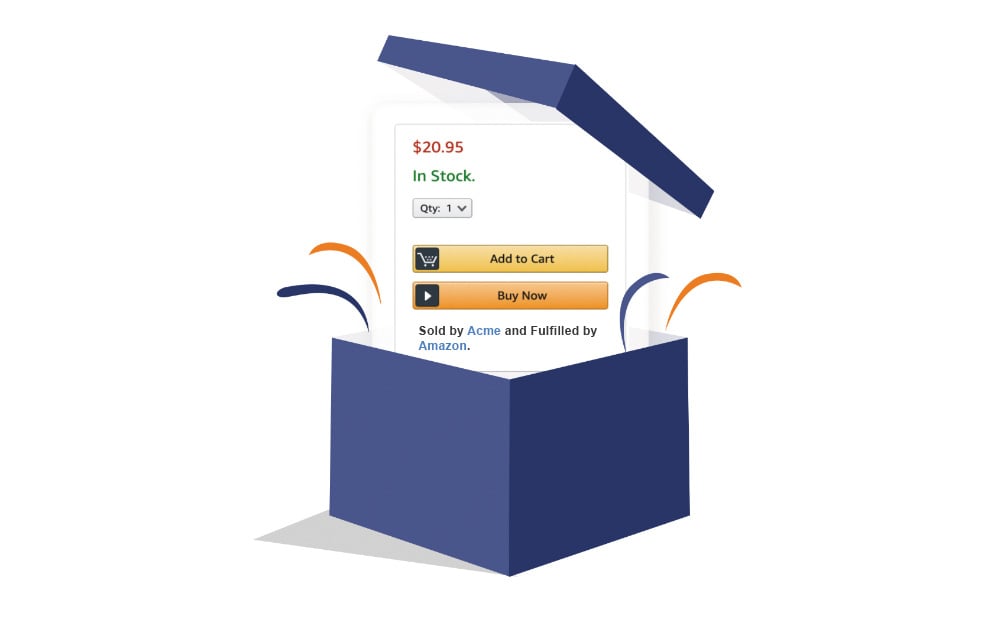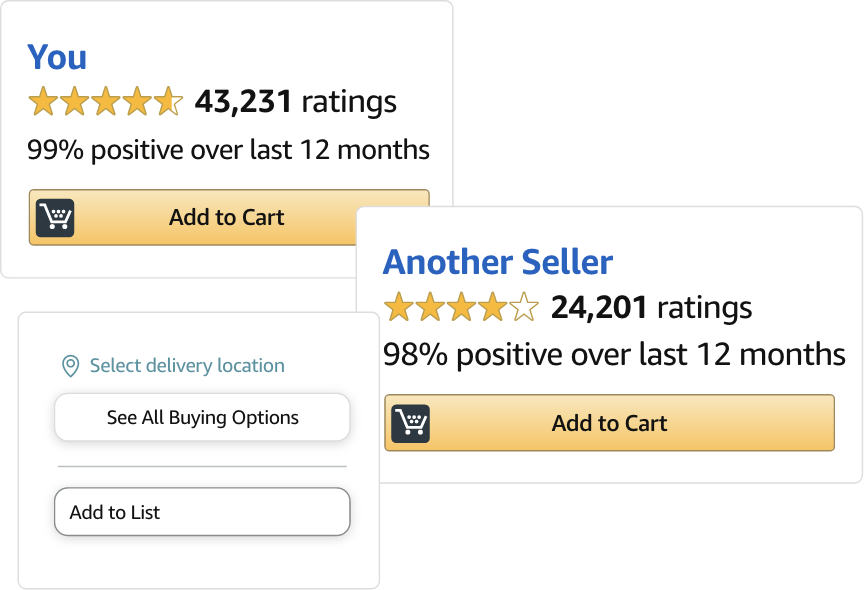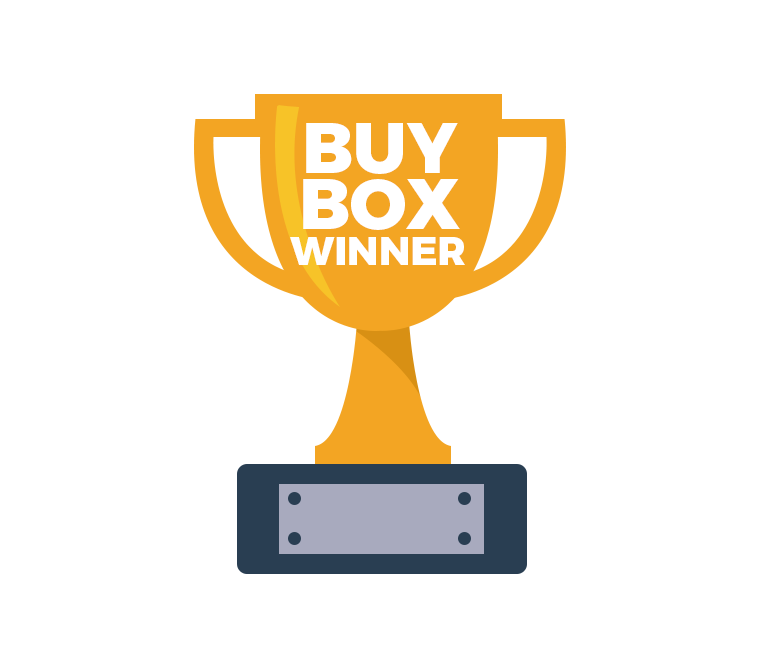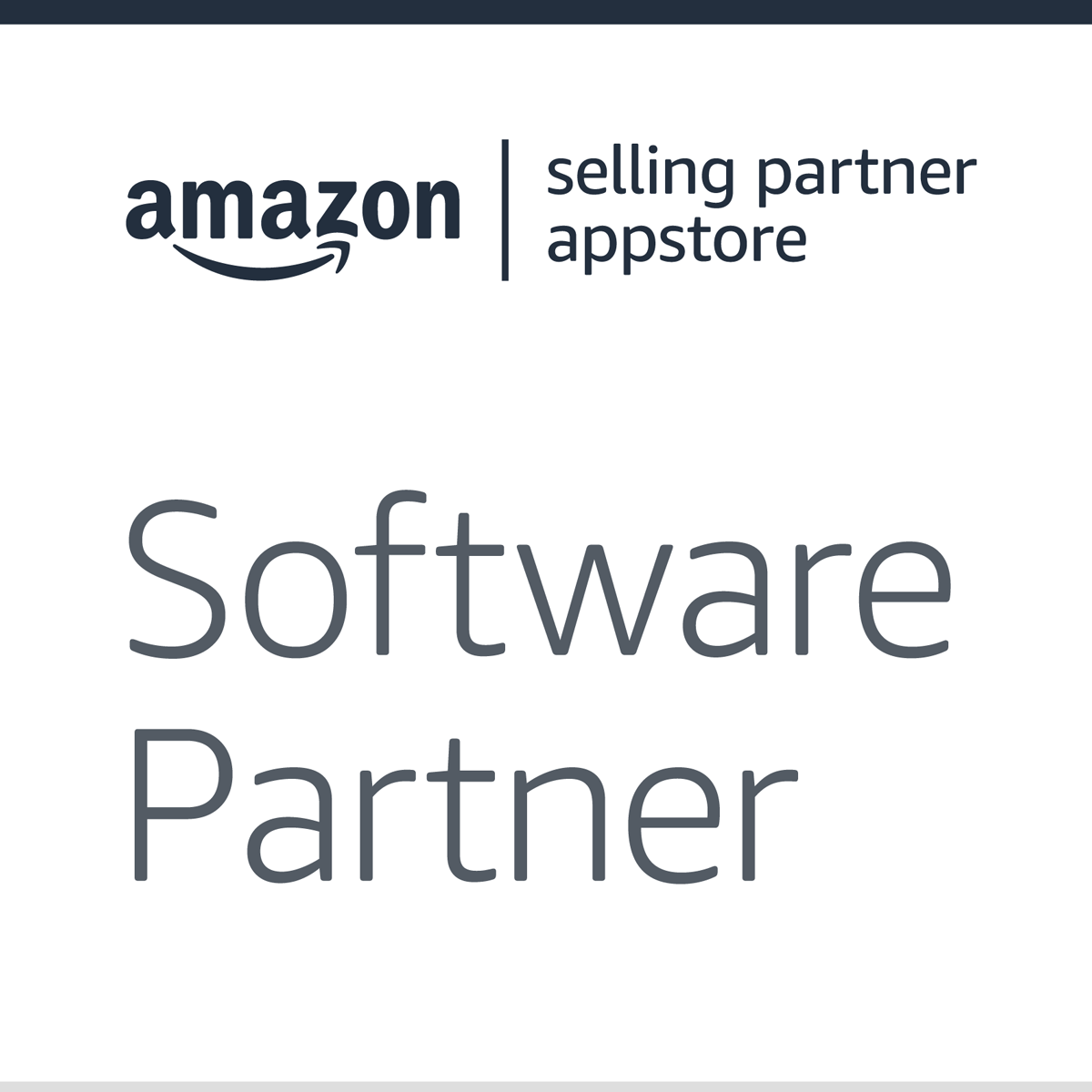Menu
Join Our Email List
- Receive our monthly newsletter.
- Stay up to date on Amazon policies.
- Get tips to grow your business.

Boost your Amazon sales by winning the Buy Box, also known as the Featured Offer.
This free guide tells you what you need to know to get (and keep) the Buy Box.
Each product detail page on Amazon contains a golden "Add to Cart" button, which shoppers can click to begin the checkout process. Some shoppers also see a "Buy Now" button, which allows shoppers to bypass the traditional shopping cart checkout process via one-click ordering. Both the "Add to Cart" and "Buy Now" buttons are, technically speaking, the "Buy Box." The Buy Box is also sometimes referred to as the "Featured Offer."
So, how does the Amazon Buy Box work from a seller's perspective? Simply put, sellers who offer the same item compete for a share of the Buy Box, which rotates between sellers. Amazon awards the Buy Box based on a variety of criteria, which are discussed below.

Increase your Amazon Buy Box eligibility with these strategies.
Make sure that your product title and description are keyword-optimized. If buyers can’t find your product in a search, it will be tough for you to win a share of the Buy Box. Your Amazon listing content is essential for search as well as shoppers, so make the most of it. An Amazon listing monitoring solution like SellerPulse can help you identify listing issues and track Buy Box status.
A product that sells steadily is in a good position to win a share of the Buy Box. Amazon’s goal is to be helpful to the customer (and get a sale) by showing a product that sells well in the Buy Box. Consistent orders show that your item is well-received by buyers. To improve order volume, consider advertising your product.
Consistent order volume won’t do you any good if you don’t have inventory in stock to fulfill orders. To truly compete for a share of the Amazon Buy Box, you need to have a clear inventory management strategy. Build strong relationships with suppliers. By doing so, you may be able to fast-track orders if your order volume suddenly spikes, and you might even qualify for special discounts. Have a backup plan for fulfilling orders when stock is running low.
Can offering your products via Amazon FBA help you win the Buy Box? Absolutely. It’s not a requirement, by any means, but FBA allows you to fulfill orders quickly with fast shipping, which is a key component of winning the Buy Box.
Can you keep up with demand and provide a good experience for all buyers? Your Amazon seller metrics, including ODR, feedback rating, and on-time shipping rate impact your chances of winning a share of the Buy Box. Regularly review your metrics and make sure your account remains in good standing with Amazon.
The lowest offer doesn’t necessarily win the Buy Box. Having a smart Amazon pricing strategy can help increase your odds. Check out your competition and make sure that your pricing is similar. An Amazon repricer can help you stay competitive as prices change. If you sell on multiple platforms, note that your Amazon listing may be suppressed from the Buy Box if you have lower prices elsewhere.
Before you can ever get your first Buy Box, you must become Buy Box eligible. New offers from FBA sellers are automatically eligible for the Buy Box.
You can check your Buy Box eligibility status in Seller Central from the Manage Inventory page. Click Preferences and then select Featured Offer eligible. Save your changes at the bottom of the page. The Featured Offer Eligible column will show whether each of your ASINs is eligible for the Buy Box.
Here are some Buy Box eligibility factors:
Important Note: Being Featured Offer Eligible does not necessarily mean that you will win the Buy Box. Also, Featured Offers are shown at the ASIN level. If you have multiple variations for a product, you may win the Buy Box for some of them and not others, because each variation is a separate ASIN.

These strategies will help you maintain a healthy share of the Buy Box.
To have what it takes to win the Buy Box, you need to consistently show Amazon that you are up to the task of keeping shoppers happy. Make sure everyone in your company knows your customer service processes.
Are your items priced competitively? Pricing lower than the competition doesn't guarantee you'll capture a higher percentage of Buy Box sales. To truly compete, you must be prepared to reprice products based on other offers and Amazon's pricing recommendations. You can see which offer is winning the Featured Offer on the Manage Pricing page and get real-time data about how your prices compare to others on the Pricing Health page.
Amazon metrics such as Order Defect Rate, Cancellation Rate, and Late Shipment Rate play a role in determining who wins the Buy Box because these numbers tell Amazon how well you meet buyer expectations. Keep your account healthy and in good standing.
Amazon has led the charge in offering fast and free shipping to online shoppers. Offering Prime shipping can increase your chances of keeping the Buy Box.
A great seller feedback score can give you a leg up on the competition by showing Amazon that customers are satisfied with your performance as a seller. On the ASIN level, good product reviews help boost your items in Amazon's search results. Continue to request feedback and reviews to keep your Amazon seller reputation healthy.
You'll never win the Buy Box if you're out of stock. Keep your Amazon inventory updated and be prepared to restock inventory for items that sell quickly. Look out for low and out-of-stock inventory alerts in Seller Central, or use an inventory management tool that lets you know when to restock to avoid stockouts.
The exact Amazon Buy Box algorithm is a closely guarded secret, but we do have an idea of factors that influence the algorithm and, subsequently, Buy Box rotation. Ultimately, Amazon's goal is to connect shoppers with sellers who can meet strict seller performance standards because those sellers are more likely to deliver a satisfactory experience for the customer. The good news is that you control many aspects of the overall customer experience. There are strategies you can implement to help increase your odds of meeting Amazon's high standards for getting the Buy Box, such as enrolling your products in Amazon FBA.
On-time shipping is a major component of the Buy Box algorithm, so offering Prime shipping via FBA or Seller Fulfilled Prime can be a game changer. Competitive pricing, Order Defect Rate, valid tracking rate, and seller feedback rating are considered as well. The amount and recency of feedback also seem to be important, with newer and more frequent seller feedback providing a leg up over the competition. Customer response time, on-time delivery rate, cancellation rate, inventory in stock, and sales volume are also factors.

Jay Lagarde
Founder and President, eComEngine
"Buy Box metrics are just one of the critical factors Amazon sellers should be watching.
Understanding the factors that go into it and where you do and don’t have control will help you continue to grow a thriving Amazon business."

Liz Adamson
Amazon consultant

James Thomson
Co-founder of Prosper Show

Colleen Quattlebaum
eCommerce consultant
Learn why you might lose the Buy Box and how to avoid doing so as competition heats up.
While competing offers often impact a seller's Buy Box share, losing the Buy Box as the only seller of a particular ASIN is possible. There are a variety of reasons for this, from shipment methods to a change in consumer demand. No matter your selling model, it's important to maintain healthy account metrics. A Buy Box tracker like SellerPulse can help you monitor your status and act quickly if you lose the Buy Box.
You can't be everywhere at once. Since the Buy Box is designed to help buyers find the best deal with the fastest delivery time, you could lose the Buy Box due to your location. If your product can't arrive at a buyer's door within 48 hours (say, if you're on the East Coast and the buyer is in Alaska), you may not appear as the Featured Offer.
Unauthorized sellers and counterfeit products can cause all kinds of nightmares for your business. You may find yourself losing the Buy Box to a competing listing that is a fake product, allowing that seller to reduce their price drastically. If you are a brand owner, register your brand and consider enrolling in Amazon Transparency to protect your listings.
If your inventory in stock at Amazon's fulfillment centers is dwindling, you might find that you're no longer winning a share of the Buy Box.
Selling CRaP (Can't Realize a Profit) items, which are unprofitable for Amazon, can also cause you to lose your share of the Buy Box. Landing on Amazon's CRaP list could result in no future orders for that product. Items that are consistently out of stock, oversized or heavy, and have a small profit margin or slow sales velocity are at high risk of ending up on this list.
The landed price for your product is the total price, including shipping and handling and additional fees such as VAT. If your landed price is too low to compete with other sellers, your listing might not be in the Buy Box.
If your product is offered at a lower price on another platform, the Buy Box may be suppressed. SellerPulse alerts include the competitive price threshold so you know what you're competing against.

If total Buy Box domination is your goal, consider creating private-label items or bundled products unique to your brand. By owning the ASIN, you theoretically own 100 percent of that item's Buy Box. That said, you'll also be responsible for creating demand for the ASIN among hundreds of millions of other products already being sold on Amazon. Check out the Product Opportunity Explorer for niche details such as search data and current competition for any product you're considering selling.
Simply figuring out how to get the Buy Box on Amazon is not a long-term guarantee for success. Your Amazon Buy Box strategy should always be a work in progress. New competitors, vying for a piece of your share, continue to enter the market each day. And, Amazon's algorithm for awarding the Buy Box will never stop evolving.
Getting alerts when there are changes to your Buy Box status can help you quickly resolve issues. SellerPulse by eComEngine includes an Amazon Buy Box report with winning and losing offer details. See the seller's name, seller rating, price, and more to see how your offer stacks up. Buy Box status alerts notify you when you win or lose the Buy Box, when the Buy Box is suppressed, and whether you lost the Buy Box to Amazon or another seller.

14321 Winter Breeze Drive
Suite 121 Midlothian, VA 23113
Call us: 800-757-6840





Copyright© 2007-2025 eComEngine, LLC. All Rights Reserved. eComEngine®, FeedbackFive®, RestockPro®, and SellerPulse® are trademarks or registered trademarks of eComEngine, LLC. Amazon's trademark is used under license from Amazon.com, Inc. or its affiliates.